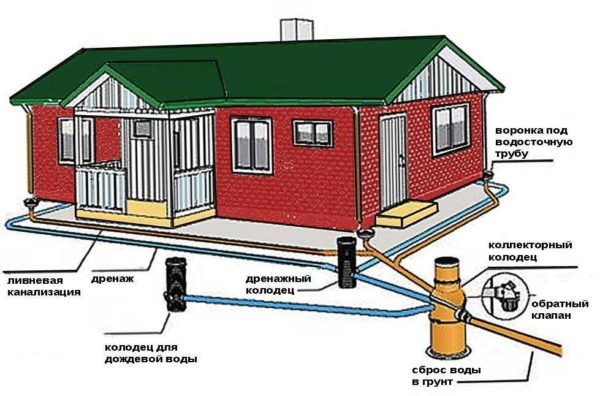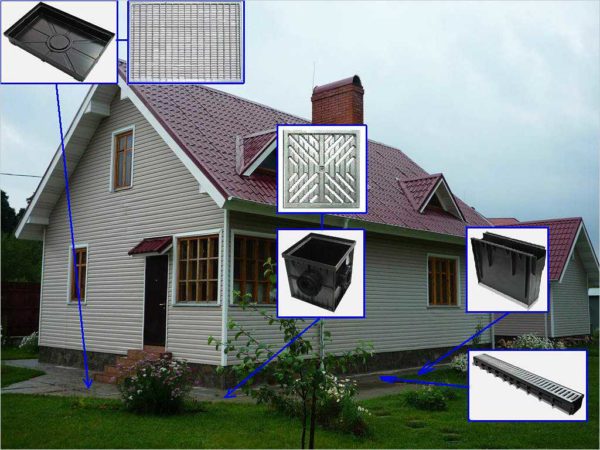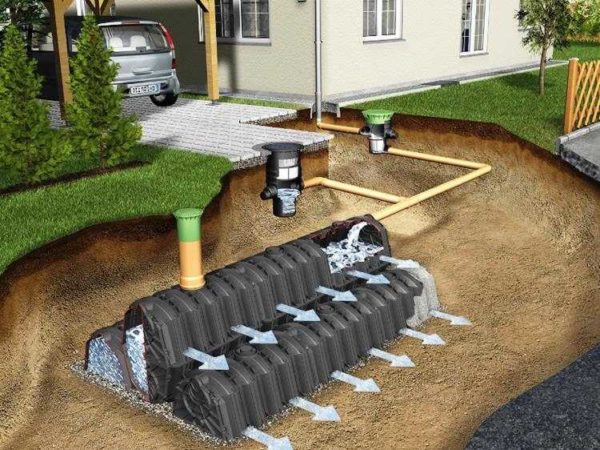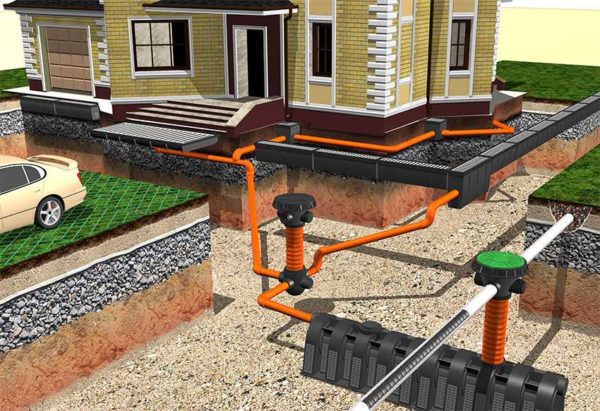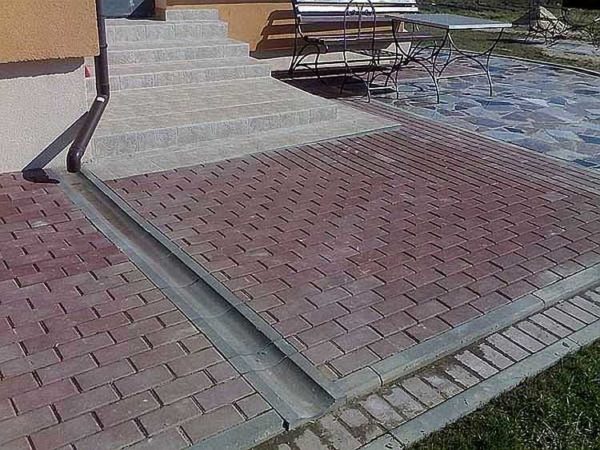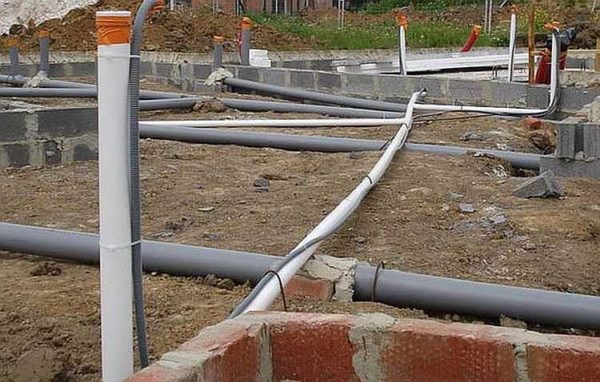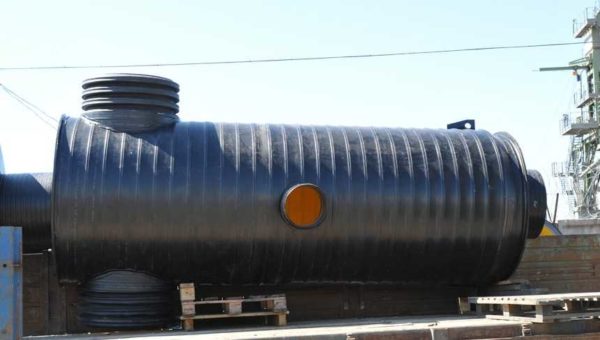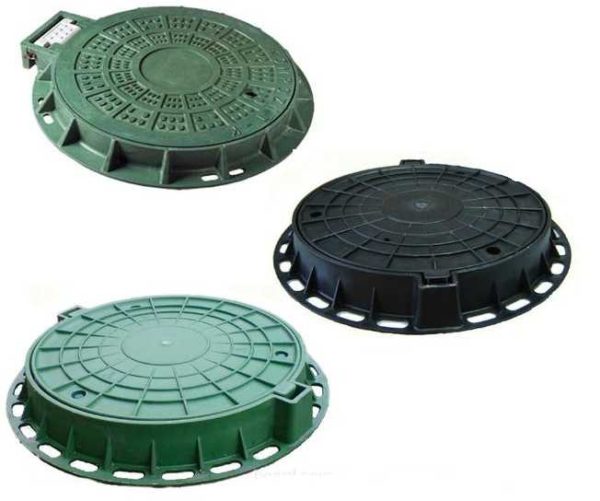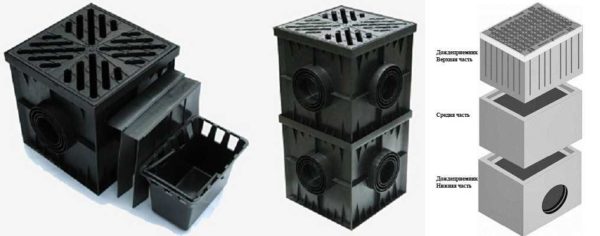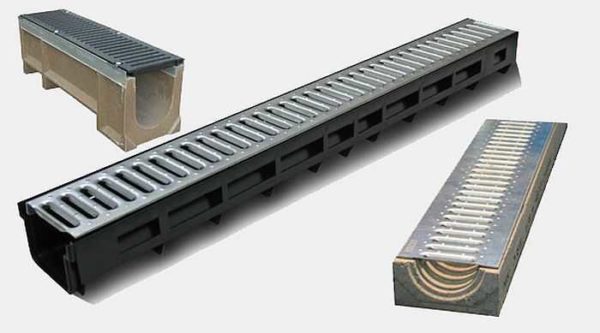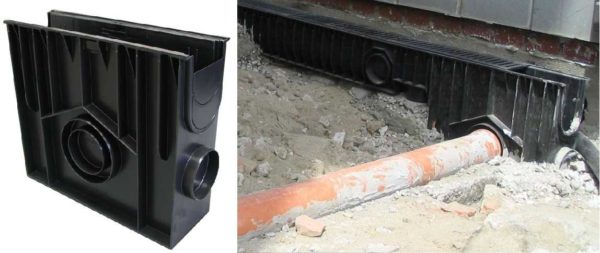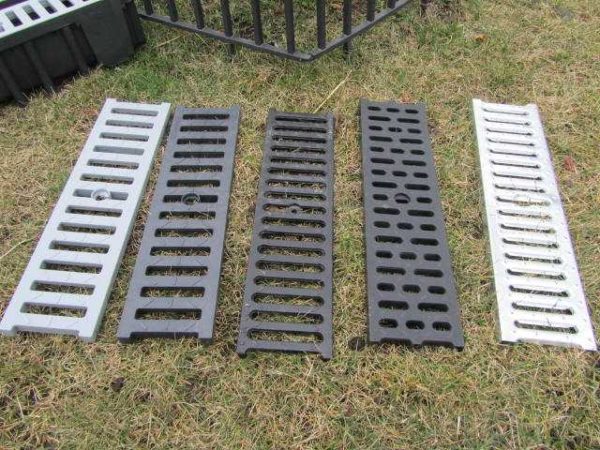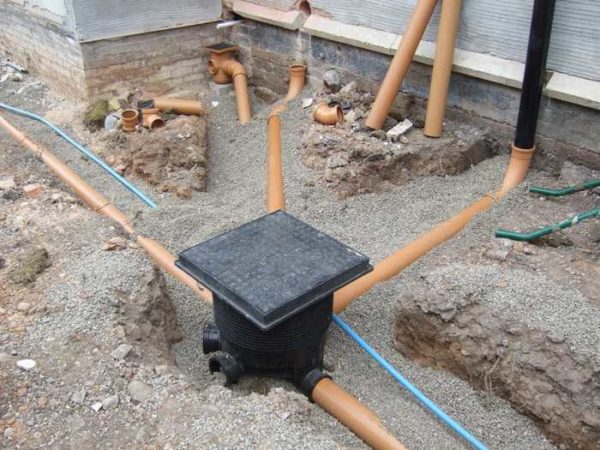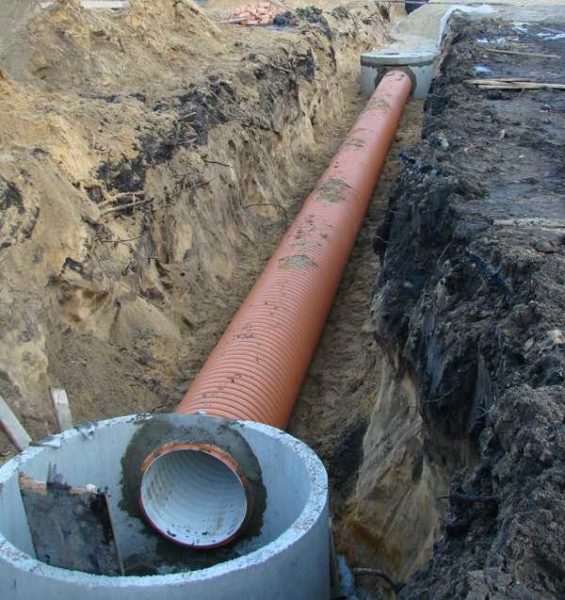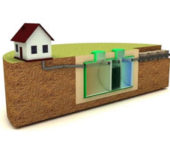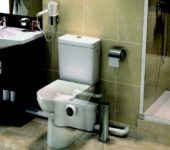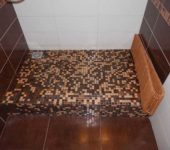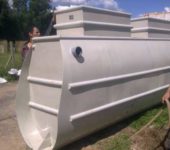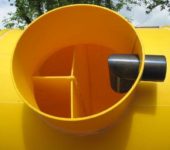Stormwater drainage in a private house
So that there is no flood on the site after each rain, so that the foundation is not wet and does not collapse, it is necessary to ensure the drainage of precipitation. This requires a rainwater drain. We can see it in cities - it is a system of water intake devices and canals. Storm sewage in a private house is smaller, but its essence is the same. This is not to say that it is easy to do it, but you can cope on your own, especially if you have already done something on the site with your own hands.
The content of the article
What is a storm sewer system of a private house and what is it like
In regions with a large amount of precipitation, it is necessary to divert rain and melt water somewhere. If this is not done, the paths are gradually destroyed, the earth in the yard becomes limp, and then dries up for a long time. If you have not yet made a blind area around the house, rainwater will wash away and gradually destroy the foundation. In general, a storm sewer in a private house is a guarantee of the longevity of your home, order and a neat appearance on your site. This type of engineering systems is also called stormwater or rainwater drainage.
The composition of the system is as follows:
- Roof drain systems. These are gutters fixed along the slopes, into which rainfall from the roof is collected. They flow downward through installed funnels and downpipes.
- A number of sediment receivers on the ground (receiving funnels, storm inlets, linear drainage systems, sand traps). They are positioned in such a way as to most effectively take precipitation. Typically, point receivers or funnels are placed under the downpipes, several receivers are placed on concrete, asphalt areas, where paving slabs are laid. Linear receivers are placed along the tracks, and in order for the water to drain normally, the coating is laid with a slight slope.
- System for storage, redistribution or discharge of precipitation.
Where to put the water
Most of the questions arise with what to do with the precipitation, which is rapidly approaching. First, a storm sewer in a private house can become a supplier of water for irrigation. To do this, all pipes of the system are brought together into a large container or several containers, and from there, with the help of a pump, they can be pumped into the irrigation system.
Secondly, if there is nothing to water or there is nowhere to put such a volume of liquid, you can drain storm water into a centralized sewage system, a gutter located near a reservoir. If these possibilities cannot be realized, they arrange a system for dumping water into the ground. These are perforated plastic pipes buried below ground level.
Types and their features
Storm sewage in a private house can be of three types:
- Underground. All parts of the system are below ground level. From an aesthetic point of view, this is great, but it requires a lot of land work and a fairly large investment. Such a system can be equipped during construction or a complete alteration of the site. There are two types of them - freezing and not. Those freezing in winter and early spring do not work, but their device is simpler - the depth is usually less than a meter (at least 30 cm). For non-freezing rainstorms, pipes must be laid below the depth of soil freezing. It is different for each region, for Central Russia it is about 150-170 cm. The pros and cons are clear at once - a large amount of land work, and therefore, their high cost.
- Aboveground.Storms of this type are gutters in the covering, through which water flows down to a certain place or is discharged into the garden / vegetable garden.
- Mixed. Part of the rainwater drainage system is made in the ground, part - from above. The best option both in terms of cost and appearance, and the amount of funds required.
In each specific case, you have to design your own scheme - there is no single recipe. Each has its own site with its features: soil absorbency, relief, buildings, planning.
What exactly needs to be done is to divert the water away from the house. This can be done as in the photo above - by installing gutters in the path and draining the water onto the lawn. But this is just one of many options. The second place where it is desirable to divert water is a vast paved area. As a rule, large puddles form here, which are difficult to deal with. The problem can be solved by making one or several water collection points - to put point storm water inlets and drain water according to one of the recipes.
Combined or separate
Often, in a private house, it is necessary to make three drainage systems at once:
- sewer;
- drainage;
- storm.
They often run parallel or close to each other. Naturally, there is a desire to save money and combine the stormwater with some other. In particular, use an existing well. I must say right away that it is better not to do this. Why? During a rainstorm, water arrives at a very high speed. On average - from 10 cubic meters per hour (maybe more). At this rate of water flow, the well fills up very quickly. It happens that it overflows.
If the discharge goes into a sewer well, water begins to flow into the sewer pipes. It will not rise above the ground level, but you cannot lower anything either - everything will be in the plumbing. After lowering the water level, debris remains inside. It interferes with the normal operation of the sewage system, you have to clean it. Not a pleasant experience.
If the discharge goes into a drainage well, the situation is even worse. During a rainstorm, water enters the system under high pressure. It fills the pipes, then pours out under the foundation, undermining it. You can imagine the consequences. There are still not so obvious things. For example, silting of drainage pipes. It is unrealistic to clean them, you have to change them. And these are big expenses and a lot of work.
So from all that has been said, we can draw a conclusion. The first is that a storm sewer in a private house must have its own well. The second - it is desirable that it be large. This is if you are not lucky to have a pond, lake or river nearby.
Stormwater components and their types
All elements of the storm sewer in a private house must be connected to the system. Here's what it can consist of:
- Well. It should be large. How much depends on the amount of rainfall, the size of the roof and the area from which the water is collected. Most often it is made from concrete rings. It differs from water only by the need to make the bottom. For this, you can put a ring with a bottom down (there are factory ones), or you can fill the stove yourself. Another option is plastic wells for rainwater drainage. They are buried to the required depth, anchored (chained) to the poured concrete platforms so as not to "float". The good solution is that there is no need to worry about the tightness of the seams - such vessels are completely sealed.
- A hatch above the stormwater well. It is best to take a ring and a separate hatch (plastic, rubber or metal - your choice). In this case, you can dig in the rings so that the upper edge of the installed cover is 15-20 cm below the ground level.Under the installation of the hatch, you will have to lay out a brick or pour a neck out of concrete, but the lawn planted on top will feel good and will not differ in color from the rest of the planting. If you take a finished cover with a hatch, you can pour only 4-5 cm of soil. On such a layer of soil, the lawn will differ in color and density, paying attention to what is under it.
- Point storm water inlets. These are relatively small containers that are installed in places where precipitation accumulates. They are placed under the drainpipes, at the lowest points of the site. The bodies of storm water inlets can be made of plastic or concrete. Concrete ones are used when installing deep-laid stormwater. They are put one on one, achieving the required height. Although today there are already built-on plastic storm water inlets.
- Linear storm water inlets or drainage channels. These are plastic or concrete gutters. These devices are installed in places with the highest rainfall - along the eaves of the roof, if no drainage system is made, along the footpaths. Can be installed under gutters as gutters. This option is good if for building a blind area around the house did not lay pipes for water drainage. In this case, the receivers are placed outside the blind area, and the other end of the tray is connected to it. This is a way to make storm sewers without destroying the blind area.
- Sand traps. Special devices in which sand is deposited. They usually put plastic cases - they are inexpensive, but reliable. They are installed at some distance from each other in extended sections of the pipeline. Sand and other heavy inclusions are deposited in them. These devices need to be cleaned periodically, but this is much more convenient than cleaning the entire system.
- Lattices. In order for the water to drain better, the holes in the grate must be large. They are:
- cast iron, a good option, but the paint does not last longer than 2-3 years even on the most expensive;
- steel - the worst option, as they rust very quickly;
- from aluminum alloys - the most durable and consistently good looking, but also the most expensive.
- Pipes. For storm sewers, it is best to install polyethylene pipes for outdoor use (reddish color). Their smooth walls do not allow sediment to accumulate, and they also have a higher conductivity than pipes of a similar diameter made of other materials. They also use cast iron and asbestos pipes. A little about the diameter of the stormwater pipes. It depends on the amount of precipitation, the branching of the system. But the smallest diameter is 150 mm, or better - more. Pipes are laid with a slope of at least 3% (3 cm per meter) towards the storm water inlets, and then towards the well.
- Revision wells. These are small plastic or concrete wells that are placed on an extended section of the pipeline, at the branch points of the system. Through them, if necessary, clean the pipes.
The storm sewer in a private house does not always contain all these devices, but it is possible to build a system of any configuration and complexity from them.
Construction procedure
In general, first you need to create a project. If there is no opportunity or desire to use the services of professionals, draw it to scale (on a piece of paper or in one of the programs). So you can quite accurately determine what you need and how much. Having purchased the necessary materials, you can start work.
First, a drainage system is installed. Then the installation of the storm sewer begins. It makes sense to carry out this work simultaneously with the laying of drainage and sewerage systems, as well as to carry out preparation work for laying paths and blind areas. All of these jobs require soil removal, so why not do it all at once?
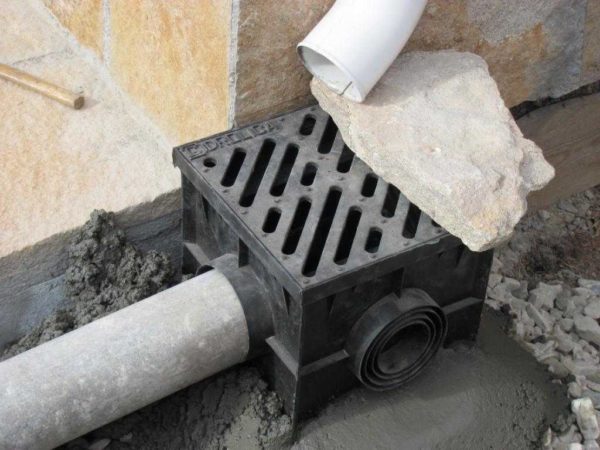
Installation of a storm water inlet - pour concrete and "load" something heavy so as not to squeeze out
If other systems are ready or simply not needed, trenches can be dug. They should be 10-15 cm deeper than the required depth. Crushed stone is poured at the bottom of the trenches, and pipes are laid in it, devices are placed. Crushed stone will neutralize the heaving forces: it always remains mobile, so that under loads it simply moves from place to place. As you know, the load devices installed in it hardly feel any load.
When installing storm water inlets, they are concreted. A formwork is placed around, it is poured with a layer of concrete 15-20 cm. It must be calculated so that the finishing coating that you are going to lay normally "lays down".

